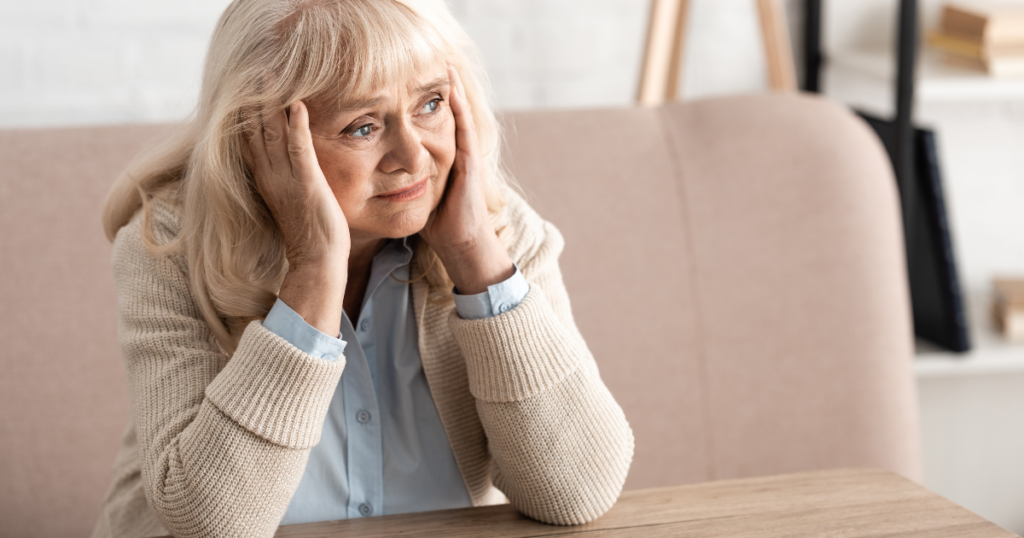Seasonal Affective Disorder (SAD) is a type of depression that occurs at a specific time of year, typically during the autumn and winter months when daylight hours are shorter. Understanding SAD is a crucial step in addressing this seasonal challenge and coming up with strategies that help.
SAD for Older Adults and People with Sight Loss
Anyone can experience SAD, but certain groups of people are more susceptible to the challenges that the colder seasons bring and may be more likely to experience symptoms.
Older adults and people with visual impairments often face similar challenges during the wintertime. Cold temperatures, harsh weather, and reduced daylight could make it difficult for anyone in general to go places or enjoy the outdoors. For older people with sight loss, tolerating the cold, navigating icy footpaths, and traveling in the dark may be altogether impossible to do independently and safely. So, they’re often stuck at home. With minimal social interaction and being in the same space day by day it’s easy to start feeling confined and isolated, which could lead to SAD.
Signs of SAD
Some common indicators of Seasonal Affective Disorder include:
- Persistent feelings of sadness or hopelessness
- A noticeable loss of interest in activities usually enjoyed
- Changes in sleep patterns
- Fatigue
- Difficulty concentrating
- Changes in appetite or weight.
After talking with several older people who experience SAD, here’s how one of them described it.
I know that I am coming down with SAD as soon as the time changes, it gets dark earlier, and, I feel, just kind of depressed and despair over the darkness. I feel like I have no energy, like I just don’t want to do anything. It’s the most loneliest time of the year. And that’s not just for me, that’s for a lot of people. – Jim from North Carolina
If you or a loved one experience these symptoms consistently and in tandem with the changing seasons, it may be an indication of SAD. Awareness of these signs is the first step towards proactive intervention and a more positive seasonal experience.
Strategies for Combatting Seasonal Affective Disorder
Here are 4 ways to combat SAD and avoid developing a deeper, prolonged state of depression.
-
- Sunlight – One effective strategy for combating SAD is to maximise exposure to natural light. Daylight can help regulate the body’s internal clock and positively affect mood. If you’re older or sight loss prevents you from doing outdoor activities, spend time in the areas of your house that let in sunlight. You could simply relax with a cup of tea or read a book by the window. When it’s warmer and it’s safe and tolerable, take walks. Fresh air and vitamin D could help you clear your mind and feel energised.
- Exercise – Regular physical activity has been proven to alleviate symptoms of depression, including those associated with SAD. You don’t have to do anything strenuous or sign up for a fitness membership. Start by sprinkling your day with movements. There are plenty of resources on the web including exercises for older adults or movements you could do while sitting down. Even turning on music and dancing could boost your mood and energy.
- Light Therapy – Light therapy could mean different things, but for treating SAD, it involves exposure to a bright light that mimics natural sunlight. This is a non-invasive way to alleviate symptoms of SAD. Search for products online that you could use to brighten your environment during the darker months. This will help regulate your circadian rhythm and improve overall well-being.
- Social Interaction – Maintaining social connections is essential for mental health, particularly during the challenging winter months. Surround yourself with supportive friends and family members, engage in social activities, participate in gatherings, if you belong to a religious organisation, or events held by sight loss and senior charities. If you are unable to get out, invite friends and loved ones to visit.
It’s important to acknowledge that Seasonal Affective Disorder is a natural occurrence. By understanding its causes and implementing proactive strategies, you can mitigate its effects and continue to be positive and joyful through the season.
Stay Connected with RealSAM
If it’s difficult to physically interact with people during the wintertime, stay connected with friends and loved ones with a RealSAM phone.
RealSAM phones are accessible, friendly, and easy to use for those who are blind, visually impaired, and those facing age related challenges. You don’t have to be intimidated by smartphones that are too complicated and hard to see. With a ‘tap to talk’ button you can use your voice to control your phone. Call, text, and save contacts by voice.
RealSAM will help you cope with SAD by making sure you’re always in touch, always have a way to reach out, or be able to laugh with your friends.
Source:
My Michigan Health, UM Health. Seasonal Affective Disorder. Available at: https://www.mymichigan.org/about/news/healthdoseblog/seasonal-affective-disorder-in-seniors/#:~:text=While%20the%20disorder%20affects%20all,other%20hazards%20of%20the%20season. (Accessed: 16 December 2023).
National Health Services, NHS Inform. Seasonal Affective Disorder. Available at: https://www.nhsinform.scot/illnesses-and-conditions/mental-health/seasonal-affective-disorder-sad/#:~:text=The%20exact%20cause%20of%20seasonal,appetite%2C%20affecting%20how%20you%20feel. (Accessed: 16 December 2023)
National Institute of Mental Health, NIH. Seasonal Affective Disorder. Available at: https://www.nimh.nih.gov/health/publications/seasonal-affective-disorder#:~:text=SAD%20is%20a%20type%20of,pattern%20versus%20summer%2Dpattern%20SAD. (Accessed: 16 December 2023).


